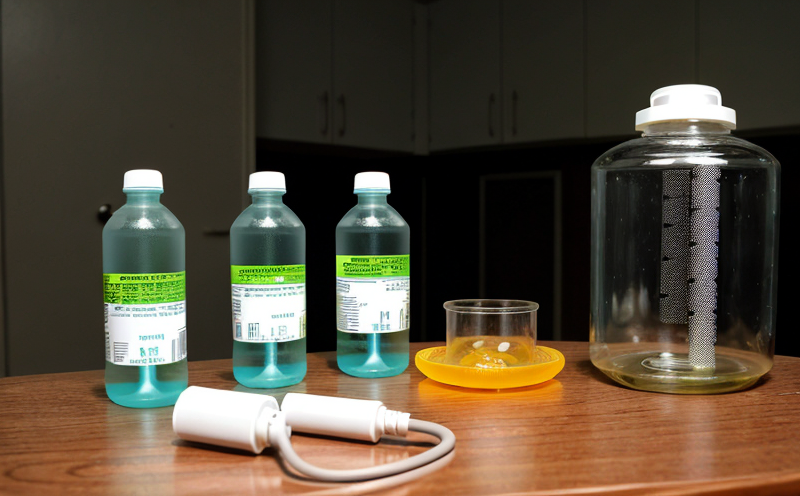ISO 10703 Gamma Emitting Radionuclides Test in Water
The ISO 10703 standard provides a comprehensive approach to detecting and quantifying gamma-emitting radionuclides in water. This method is critical for ensuring the safety of drinking water supplies, wastewater treatment facilities, and any other scenarios where water quality is paramount.
Gamma emitters are among the most hazardous radioactive materials due to their ability to penetrate through various shielding layers, posing significant health risks if not properly managed. The ISO 10703 procedure ensures that these radionuclides can be accurately identified and quantified using gamma spectrometry techniques.
The testing process begins with proper sampling of water specimens according to best practices outlined in the standard. Specimens must be stored under controlled conditions until analysis can be conducted, typically within 24 hours after collection. Once samples are ready for analysis, they undergo rigorous preparation steps including filtration and dissolution if necessary.
Instrumentation plays a crucial role in this process; high-purity germanium (HPGe) detectors are commonly used due to their high efficiency for detecting gamma radiation across various energy ranges relevant to radionuclide emissions. Calibration of these instruments is essential prior to testing, ensuring accurate results throughout the entire measurement range.
The analysis involves measuring the intensity and energies characteristic of each gamma-emitting nuclide present in the sample. This information allows for identification based on known decay patterns and half-lives associated with different radionuclides. Quantification then follows from these measurements using appropriate calibration standards.
Acceptance criteria are strictly defined within ISO 10703, specifying permissible limits of certain gamma-emitting nuclides depending upon intended use or regulatory requirements applicable to the specific water body being tested. Compliance with these limits ensures that the water meets safety and quality standards established by relevant authorities.
The results from this testing are reported in terms of activity concentrations for each detected radionuclide, expressed typically in Bq/L (becquerels per liter). Additionally, detailed reports including raw data, calibration information, and quality control measures accompany every test result provided to clients.
This service is vital not only for ensuring public health but also supporting regulatory compliance across various industries such as municipal water supply systems, nuclear power plants, pharmaceutical manufacturing facilities, and industrial processes involving large volumes of wastewater discharge. It helps protect ecosystems from contamination while safeguarding human populations exposed to potentially harmful levels of radiation.
Industry Applications
Water & Wastewater Treatment: Ensuring compliance with environmental regulations regarding radioactive substances in treated water discharged into natural bodies or used for other purposes.
- Municipal utilities monitoring discharge levels to meet EPA guidelines.
- Nuclear power plants verifying that effluent does not exceed allowable limits set by NRC/NEA/EURATOM.
| Industry | Main Concerns |
|---|---|
| Municipal Utilities | Detecting tritium, strontium-90, cesium isotopes in treated effluents. |
| Nuclear Power Plants | Monitoring for beta-particles and gamma rays emitted by uranium series products and actinides. |
Pharmaceutical Manufacturing: Verifying that water used in production processes or discharged waste does not contain harmful levels of radionuclides.
- Ensuring compliance with FDA/EMA regulations on radioactivity limits in pharmaceuticals and related materials.
- Monitoring for contaminants like technetium-99m, iodine-131 used in medical applications.
Environmental Monitoring: Investigating sources of radioactive contamination in surface waters, groundwaters, or other environmental media.
- Identifying accidental releases from industrial sites or hazardous waste management operations.
- Supporting long-term monitoring programs to assess trends over time.
Eurolab Advantages
ISO 10703 Compliance: Our laboratory adheres strictly to ISO 10703, ensuring accurate and reliable detection of gamma-emitting radionuclides in water samples.
State-of-the-Art Equipment: Equipped with advanced HPGe detectors capable of providing precise measurements across wide energy ranges required for comprehensive analysis.
Experienced Professionals: Our team comprises highly trained and certified experts who stay updated on the latest developments in radiological testing methodologies.
Comprehensive Reporting: Providing detailed reports including raw data, calibration details, and quality control metrics to give clients full transparency into their test results.
Customer Impact and Satisfaction
By offering ISO 10703 compliant gamma-emitting radionuclides testing services, we help our customers:
- Achieve regulatory compliance with minimal disruption to operations.
- Ensure product safety for end-users by eliminating risks associated with radioactive contamination.
- Minimize operational costs through informed decision-making based on accurate test results.
We are committed to delivering high-quality services that exceed expectations, fostering long-term partnerships built on trust and reliability. Our clients consistently report improved confidence in their processes and peace of mind knowing they adhere to strict safety standards.





